SEE THE SIGNS AND SYMPTOMS OF THYROID EYE DISEASE (TED)
TED can cause a wide range of visible and nonvisible signs and symptoms that can significantly impact a patient’s quality of life1-3
Early diagnosis and treatment of TED is important as sometimes damage can start before visible symptoms appear3-6
VISIBLE SIGNS
Screen patients for mild, moderate, and severe
manifestations or symptoms of TED7
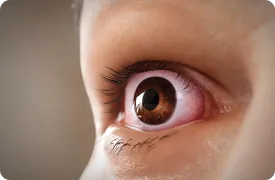
Eyelid retraction
Upper eyelid retraction is 1 of the most common symptoms of TED.8 Retraction develops from levator and Müller muscle inflammation and fibrosis, or from levator muscle overaction caused by inferior rectus restriction.7,8
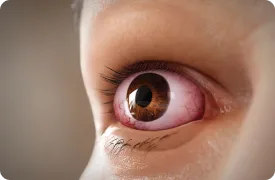
Proptosis
Proptosis is caused by the expansion of the orbital fat and muscles behind the eyes. Proptosis is 1 of the most common symptoms of TED.8
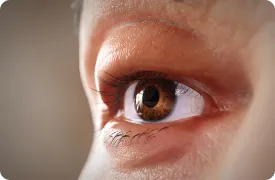
Redness and swelling
Erythema (redness) and edema (swelling) of the eyelids are common symptoms of TED.1,8
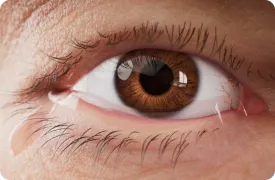
Watery eyes
Eyelid retraction combined with proptosis can lead to reflex tearing.7
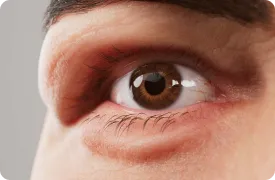
Soft tissue changes around eye
TED can cause an increase in the orbital soft tissue volume, which leads to higher pressure within the inexpandable bone cavity.8
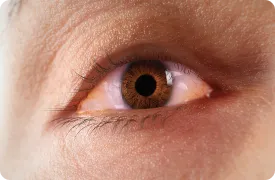
Chemosis
The conjunctiva that covers the sclera swells, making the eye look red and puffy. Fluid can build up under the membrane, making it look like there is a big, red blister in the eye.8,9
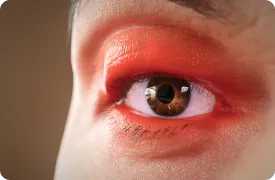
Eyelid erythema
Also known as periocular dermatitis or periorbital dermatitis, eyelid erythema presents with a scaly, erythematous eruption of the upper and lower eyelids, resulting in swollen eyelids that often itch, burn, sting, and look red.8,10
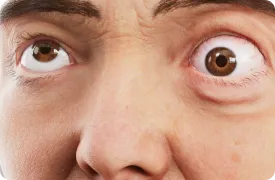
Extraocular muscle restriction
Inflammation of the extraocular muscles is a common manifestation of TED that can lead to restricted eye movements and proptosis. This can be caused by rectus muscle swelling or by fibrotic changes.11
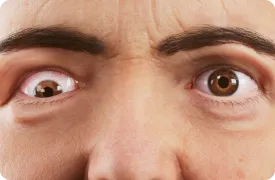
Strabismus
Strabismus, also known as misalignment of the eyes, can lead to diplopia and interfere with a patient’s ability to work, read, drive, and complete other daily functions.12
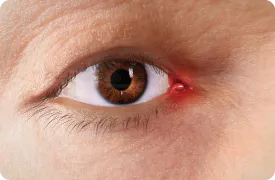
Inflammation of the caruncle or plica
Swelling of the small, pink, globular nodule at the inner corner (the medial canthus) of the eye.8,13
TED is more than proptosis—the nonvisible symptoms can be just as serious14
- In 1 study of patients diagnosed with both TED and Graves’ disease, orbital MRI revealed extraocular muscle swelling in 71% (n=17) of untreated Graves’ disease patients who showed no visible signs of TED5
- This swelling could explain why some TED patients first experience nonvisible symptoms before presenting with visible signs8
The signs and symptoms of TED make patients put parts of their lives away.2 Use the Patient Intake Form to gain more insight on how the signs and symptoms of TED can impact your patient’s life.
NONVISIBLE SYMPTOMS
Monitor your patients for new or worsening nonvisible
symptoms of TED
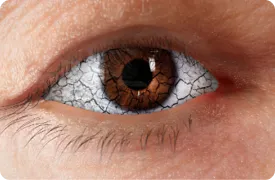
Dry eyes and grittiness
Dry eyes and grittiness are frequently overlooked symptoms of TED.15 These symptoms are often misdiagnosed as dry eye disease, allergies, or conjunctivitis.16
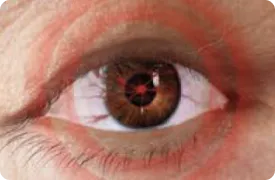
Spontaneous orbital pain
The feeling of pain or pressure behind the eye. It can be caused by a variety of conditions and is usually described as a deep, dull ache behind or within the eye itself.8,17
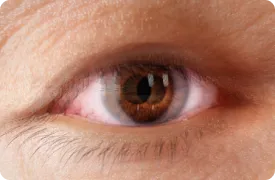
Diplopia
Diplopia is caused by swelling and inflammation of the extraocular muscles and typically restricts the movement of the eye, causing double vision. The most frequently involved muscle is the inferior rectus.1
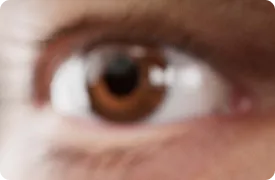
Blurred vision
Some patients can’t see things clearly in either 1 or both eyes. This can make it difficult to perform daily activities.18
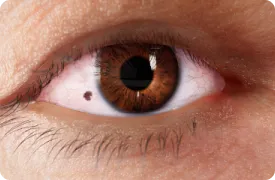
The feeling of something stuck in the eye
Some patients may feel like a piece of dust or dirt is stuck in their eye even though nothing is really present—a phenomenon known as “foreign body sensation.”19
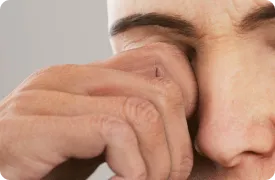
Itchy eyes
TED can cause dryness, which leads some patients’ eyes to feel itchy. Patients will often use lubricating eye drops for temporary relief.20
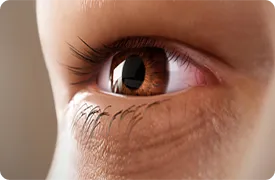
Photophobia
Photophobia, or light sensitivity, often occurs in TED patients when the upper eyelid retracts, resulting in corneal exposure.7
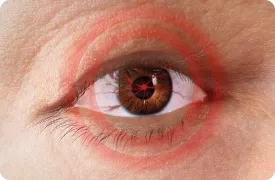
Pressure and/or pain behind the eyes
As a result of inflammation, TED patients can experience the feeling of pressure or pain. This can feel like a dull ache and/or sharp, shooting pains.8,17
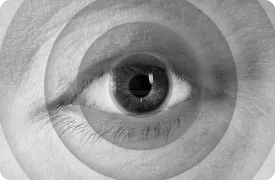
Color vision loss
Also known as acquired color vision deficiency, color vision loss can be a result of damage to the optic nerve, and there is a risk of vision loss. Colors may not appear as bright as they once were, or there could be a difference in the brightness of colors when comparing one eye with the other. In rare cases, some patients may become color blind.18,21-23
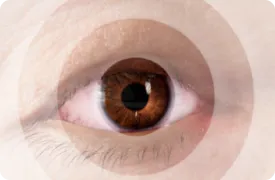
Vision loss
In some cases, patients may notice some vision loss, or they may experience complete vision loss. This occurs because TED can cause swelling behind the eye that pushes down on the optic nerve. If this happens, emergency surgery may be needed to save the patient’s vision. Optic nerve damage in TED patients can lead to blindness, but it’s very rare.11,23,24

As a thyroid endocrinologist, I am in a position to identify signs and symptoms of TED early, especially in those already facing thyroid issues. By detecting and addressing TED sooner, we can truly make a difference in helping our patients feel better and restoring their quality of life."
— Dr Eve Bloomgarden, endocrinologist
NONVISIBLE SYMPTOMS, SUCH AS EYE PAIN AND DOUBLE VISION, ARE SOME OF THE MOST BURDENSOME SYMPTOMS OF TED THAT MOST OFTEN LEAD PATIENTS TO SEEK MEDICAL HELP2
RISK OF MISDIAGNOSIS
TED is a heterogenous disease, sometimes making it difficult to differentiate from other conditions16,21,22
- Symptoms may resemble those of dry eye disease, allergies, or conjunctivitis16
- TED is also linked to thyroid conditions such as Graves’ disease or Hashimoto’s disease25
- When making a differential diagnosis, it is important to screen patients with these other conditions for TED3,16,25
THESE SIGNS AND SYMPTOMS CAN BE DEBILITATING, BUT THE TRUE IMPACT OF TED GOES BEYOND THE EYES —ASK HOW THE DISEASE IS AFFECTING PATIENTS’ QUALITY OF LIFE.26,27
- Bahn RS. Graves’ ophthalmopathy. N Engl J Med. 2010;362(8):726-738.
- Cockerham KP, Padnick-Silver L, Stuertz N, Francis-Sedlak L, Holt RJ. Quality of life in patients with chronic Thyroid Eye Disease in the United States. Ophthalmol Ther. 2021;10:975-987.
- Burch HB, Perros P, Bednarczuk T, et al. Management of Thyroid Eye Disease: a consensus statement by the American Thyroid Association and the European Thyroid Association. Thyroid. 2022;32(12):1-32.
- Kilicarslan R, Alkan A, Ilhan MM, Yetis H, Aralasmak A, Tasan E. Graves’ ophthalmopathy: the role of diffusion-weighted imaging in detecting involvement of extraocular muscles in early period of disease. Br J Radiol. 2015;88(1047):20140677.
- Villadolid MC, Yokoyama N, Isumi M, et al. Untreated Graves’ disease patients without clinical ophthalmopathy demonstrate a high frequency of extraocular muscle (EOM) enlargement by magnetic resonance. J Clin Endocrinol Metab. 1995;80(9):2830-2833.
- Smith TJ, Hegedüs L. Graves’ disease. N Engl J Med. 2016;375(16):1552-1665.
- Dolman PJ. Grading severity and activity in Thyroid Eye Disease. Ophthalmic Plast Reconstr Surg. 2018;34(4S suppl 1):S34-S40.
- Barrio-Barrio J, Sabater AL, Bonet-Farriol E, Velázquez-Villoria Á, Galofré JC. Graves’ ophthalmopathy: VISA versus EUGOGO classification, assessment, and management. J Ophthalmol. 2015;2015:249125.
- Chemosis. Mt Sinai. Accessed May 15, 2024. https://www.mountsinai.org/health-library/symptoms/chemosis
- Eyelid Dermatitis. Cleveland Clinic. Accessed May 15, 2024. https://my.clevelandclinic.org/health/diseases/21930-eyelid-dermatitis
- McAlinden C. An overview of thyroid disease. Eye Vis (Lond). 2014;1:9.
- Akbari MR, Mirmohammadsadeghi A, Mahmoudzadeh R, Veisi A. Management of Thyroid Eye Disease-Related Strabismus. J Curr Ophthalmol. 2020;32(1):1-13.
- Okumura Y, Takai Y, Yasuda S, Terasaki H. Bilateral lacrimal caruncle lesions. Nagoya J Med Sci. 2017 Feb;79(1):85-90.
- Wang Y, Patel A, Douglas RS. Thyroid Eye Disease: how a novel therapy may change the treatment paradigm. Ther Clin Risk Manag. 2019;15:1305-1318.
- Bartley GB. The epidemiologic characteristics and clinical course of ophthalmopathy associated with autoimmune thyroid disease in Olmsted County, Minnesota. Trans Am Ophthalmol Soc. 1994;92:477-588.
- Couch SM. Thyroid Eye Disease: timely diagnosis is key to controlling this autoimmune condition. Glaucoma Today. January/February 2019. Accessed January 20, 2023. https://assets.bmctoday.net/glaucomatoday/pdfs/0119GT_F2_Couch.pdf
- Eye Pain. Emedicinehealth. Accessed September 25, 2023. https://www.emedicinehealth.com/eye_pain/article_em.htm
- Thyroid Eye Disease (TED) fact sheet. PreventBlindness.org. Accessed June 8, 2022. https://www.preventblindness.org/thyroid-eye-disease
- Foreign body sensation. University of Michigan: The Eyes Have It. Accessed May 28, 2024. https://kellogg.umich.edu/theeyeshaveit/common/foreign_body_sensation.html
- Caring for your eyes with Thyroid Eye Disease. WebMD. 2022. Accessed July 30, 2024. https://www.webmd.com/eye-health/thyroid-eye-care
- Bothun ED, Scheurer RA, Harrison AR, Lee MS. Update on Thyroid Eye Disease and management. Clin Ophthalmol. 2009;3:543-551.
- Verity DH, Rose GE. Acute Thyroid Eye Disease (TED): principles of medical and surgical management. Eye (Lond). 2013;27(3):308-319.
- Liaboe CA, Clark TJ, Simmons BA, Carter K, Shriver EM. Thyroid Eye Disease: an introductory tutorial and overview of disease. April 23, 2020. Accessed on January 24, 2023. https://eyerounds.org/tutorials/thyroideye-disease/index.htm
- American Thyroid Association. Graves’ eye disease brochure. Accessed May 15, 2024. https://www.thyroid.org
- Jain AP, Jaru-Ampornpan P, Douglas RS. Thyroid Eye Disease: redefining its management—a review. Clin Exp Ophthalmol. 2021;49(1):203-211.
- Kahaly GJ, Petrak F, Hardt J, Pitz S, Egle UT. Psychosocial morbidity of Graves’ orbitopathy. Clin Endocrinol (Oxf). 2005;63(4):395-402.
- Estcourt S, Vaidya B, Quinn A, Shepherd M. The impact of thyroid eye disease upon patients’ wellbeing: a qualitative analysis. Clin Endocrinol (Oxf). 2008;68(4):635-639.
Receive the latest news and updates about Thyroid Eye Disease (TED).
